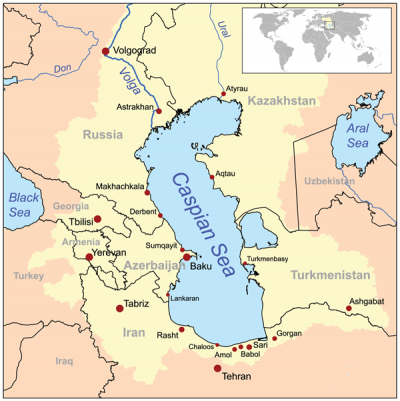Nagorno-Karabakh Standoff: Geopolitical Struggle in the Caspian Sea Region

The arc of instability amid the oil rich Southern Caspian and the Middle East made the South Caucasus region another stage for geopolitical struggles. The Nagorno-Karabakh conflict is a small, but a key block of this arc. Armenia, Azerbaijan and Russia have been involved in conflict since its very beginning. Initially, between 1988-1994, Armenia gained the upper hand and contributed to the establishment of the so-called Nagorno-Karabakh Republic.
It’s an independent, but unrecognized state established on the basis of the Nagorno-Karabakh Autonomous region, populated by mainly Armenians, of the former soviet Azerbaijan republic. As a result, Yerevan wants to maintain control of Nagorno-Karabakh. Azerbaijan seeks to regain control however, even by military means. Russia’s direct interest is to avoid escalation in the conflict near the southern border.
Moscow systematically calls for negotiations between the two sides. However, there are a number of crucial differences between Armenia and Azerbaijan. Armenia has a modern history of the cooperation with Russia and 5,000 Russian troops are deployed in the Russian military base in the country. In the new millennium Azerbaijan had been moving closer to Turkey and the US. Simultaneously, Azerbaijan made all efforts and used a good share of oil revenue to build up the national military forces.
Baku’s defense expenditures rose to the point that they eclipsed Armenia’s entire national budget. Azerbaijan made reclaiming Nagorno-Karabakh an official priority, but refrains from military operation because of Russian response in the full-scale peace-enforcement action in the region. In recent times, the relations between Azerbaijan and the EU became cooler and Baku even allowed itself diplomatic demarches. The relations with the US are friendlier. On the one hand, Baku seeks from the US money, political support, and technologies. On the other hand it can’t abandon domestic stability, fruitful relations and trade with Russia and the progressive construction of a multinational prosperous state, as its declared aim.
READ MORE: Asia on the Brink of a New Cold War?
This status quo has been rapidly changing because of the aggravation of the international situation in the South Caucasus, the Middle East and Central Asia. At the same time, Azerbaijan and Armenia became more aggressive on the line of contact in Nagorno-Karabakh. Raids into the disputed territory have increased significantly. Instances such as the shooting down of an Armenian helicopter by Azerbaijani forces or the recent heavy shellings have become commonplace in the region.
Some of the global and regional forces are interested in the conflict escalation that allows them to gain new opportunities. It is good fishing in troubled waters. The US seeks to obtain a range of tools to deal with the South Caucasus region in order to exercise control over the gas and oil transit. Meanwhile, the US has tried to destabilize the situation in Armenia to break its alliance with Russia. So-called, “electro-maidan” had all initial attributes of the US-led coups in the post-USSR states. The Armenian government reacted promptly and the coup attempt was neutralized. If, somehow, pro-US forces get power in Armenia, the Russian military base would be closed or troubled.
Thus, the only power which keeps the shaky peace in Nagorno-Karabakh would lose its direct and immediate influence. In turn, Russia has been conducting an unprecedented level of diplomatic work aimed to maintain the peace. In recent months, Russian and Azerbaijani political and military officials have met several times, with follow-up visits between Russian and Armenian officials. In case of the Russian diplomatic success, parties could make an arrangement that will likely lead to decline of the tensions.
Nevertheless the standoff between Armenia and Azerbaijan over the Nagorno-Karabakh entered a new phase. Both sides have ramped up military exercises in recent months. The contemporary situation could deconstruct the web of political alliances and relationships that keep the fragile peace in the Caucasus region. This disruptive process should lead to renewing of the war and further destabilize the whole Caspian Sea region. The region is affected by a number of destructive forces, like ISIS or local criminal clans who are directly interested in the destabilization over there. Moreover, the public opinion of Azerbaijan tends to believe that the military solution is the lesser of two evils. Washington’s tactical aim in this situation is to gain an additional ace to put pressure on Russia during the bargain over the military actions in the Middle East and a political settlement to the Syrian conflict with the key question of President Assad’s b status.

